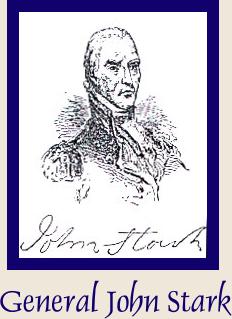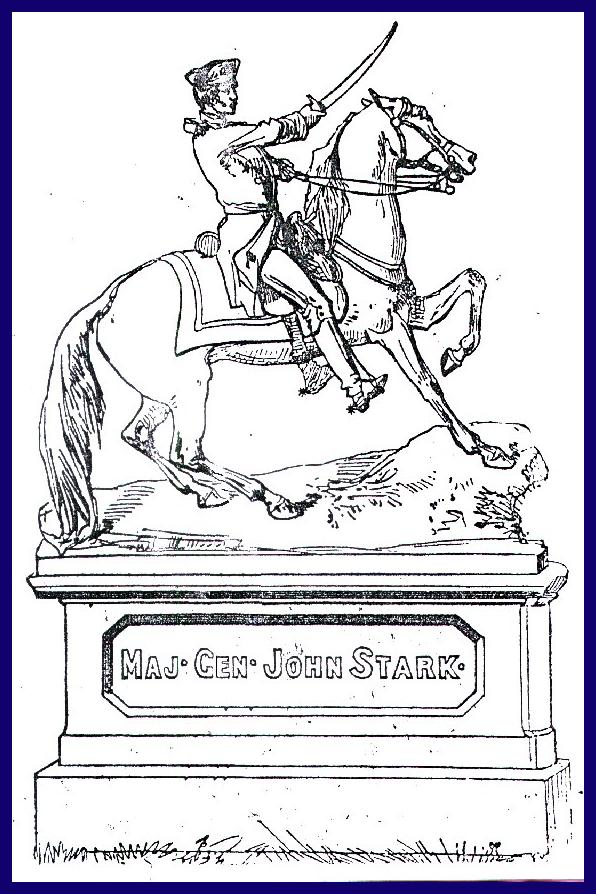
Molly Stark State Park Molly Stark State Park is named after the famous wife of General John Stark of the Revolutionary War. The park is located along the "Molly Stark Trail," Route 9, which bisects southern Vermont. Originally, the first settlers used the area for farming. During the 1930s the Civilian Conservation Corps (CCC) built fireplaces and a toilet building, but there is no evidence that this area was used by the public for camping� even though local people may have used the land for picnics. The area was designated and opened as Molly Stark State Park on July 2, 1960. The park has open lawn areas, woods, and Mt. Olga rising to the east where there is an old fire tower with spectacular views. The area is very popular during the fall foliage season for its colors, and also because it is located on one of the more popular travel routes. Facilities: Two camping loops consist of 23 tent/trailer sites and 11 lean-to sites. One rest room with showers ($) is located in each loop. There are a play area and a picnic pavilion for large groups. A hiking trail starts from the park and goes up to the Mt. Olga fire tower. Area Attractions: Gondola, Mt. Snow; Vermont Historical Society, Norton House Museum, Hermitage Sugar house and Game Bird Farm, 1836 Country Store Village, Maple Grove Honey Museum, Wilmington; Brattleboro Museum and Art Center, Brattleboro; Luman Nelson Wildlife Museum, Marlboro; Bennington Museum, Bennington. NEW HAMPSHIRE'S most famous soldier, Gen. John Stark, the hero of Bunker Hill and Bennington, was the right man in the right place at the right time. His early training with his father in heavy farm work and lumbering operations, his later practice in hunting and trapping, his capture by the Indians and his study of their language and customs, all led to his success as a member of Rogers' Rangers in the French and Indian Wars. This in turn fostered the soldierly quality of leadership that he showed so strongly in the Revolution. He developed an ability to foresee what the enemy would do and to forestall him, thus gaining distinction among Revolutionary officers. Stark's life encompassed the whole revolutionary period, and he was instrumental in the cataclysmic events that produced a free and independent nation. John Stark was born in Londonderry, New Hampshire, August 28, 1728. When he was eight years old he moved with his family to Derryfield (Manchester), his home for the remainder of his long life. Rodgers' Rangers & Molly Stark He was commissioned a 2nd Lieutenant in Rogers' Rangers attached to Col. Blanchard's regiment at the outbreak of the French and Indian Wars. In 1758, hearing of his father's death, he obtained a leave of absence to come home to help settle the estate. At this time he was a frequent visitor to the Page homestead in Dunbarton and on August 20, 1758, he and Elizabeth Page were married. From that time on, she was known as Molly Stark. The couple settled in the Page home but after a few weeks of inactivity, Stark eagerly responded to Gen. Amherst's request to build a road from Crown Point to Fort No. 4, Charlestown. It soon became apparent that resentment of the British was building. The rangers, a rough and independent lot, were consistently made to feel inferior to the British. Army discipline was severe and unyielding and the rangers were in no mood to endure it. In 1760, the French capitulated and Stark, after a dispute with his superiors, was glad to come home to build up the family property. His father's estate settled, he bought the land his brothers and sisters had inherited and became sole owner of a substantial estate. He and Molly were now living with his mother in Derryfield. Resentment of British soldiery following the French and Indian Wars came to the surface as King George imposed more and more taxes on the colonies. The Stamp Act of 1765, the Boston Massacre of 1770, the tea tax resulting in the Boston Tea Party of 1773-all were sparks helping ignite the conflagration which would soon envelop the colonies. War Breaks Out The Battle of Lexington and Concord was the opener, followed by the Battle of Bunker Hill on June 17, 1775. Stark was a formidable antagonist in that battle and following it was attached to the Continental Army under George Washington. He took part in the New Jersey campaign and commanded the right wing at Trenton. Knowing how New Englanders would ally to Stark's call, Washington sent him home to recruit new troops. Stark was in a cheerful and optimistic mood as he travelled around the settlements, talking to farmers and townsmen as he recruited replacements for the troops. But the calm was abruptly shattered when word reached Stark that Col. Enoch Poor of the Second New Hampshire Regiment had been promoted to brigadier general. This was the last straw for Stark, whose limited patience had run out. It was not the first time he had been passed over for lesser men with less experience but with more social graces and more tactful tongues. He appeared before the Exeter Legislature and resigned his commission, receiving their vote of thanks for his services. In spite of urgent efforts to get him to reconsider, Stark remained adamant, though he pledged immediate assistance to New Hampshire should it be needed. After four months as a private citizen, Stark was asked by the Exeter Legislature to accept a commission as brigadier general of the New Hampshire militia He agreed on condition he be answerable only to New Hampshire. This proved to be wise. When ordered to join Schuyler at Saratoga, Stark refused and went instead to Bennington. The Battle of Bennington, often called the turning point of the war, led directly to the Battle of Saratoga where Burgoyne was defeated. The war dragged on for six more years. Stark sometimes took part and sometimes, when cold weather settled in, went home to recuperate from the attacks of rheumatism that were to plague him the rest of his life. Retirement In Manchester At the close of the Revolution, he settled down on the home farm. He and Molly now had ten children, five boys and five girls, having lost one daughter in infancy. In 1783, John Stark was ordered to headquarters by Washington, given the personal thanks of the Commander-in-Chief and the rank of Major General by brevet. Molly Stark died of typhus in 1814, aged 78. John was 86. He lived to his 94th year and died May 8, 1822, reportedly the last surviving Continental� general of the Revolution. By Isabel Tarant; Originally published in "NH: Years of Revolution," Profiles Publications and the NH Bicentennial Commision, 1976. MOLLY STARK� (1737-1814) ------------------------------------------------------------------------------ -- Elizabeth "Molly" Page was born in Haverhill, New Hampshire, the daughter of the first Postmaster of New Hampshire. She married John Stark in 1758; they had eleven children. What is now Vermont Route 9 between Brattleboro and New York State west of Bennington was the route taken by General Stark as he led his troops from what is now Charlestown, New Hampshire across Vermont to defeat the British in the Battle of Bennington in August 1777. To confuse the enemy, General Stark referred to the route they were taking as "the Molly Stark Trail"; it is still identified as such on the offical Vermont Highway Map. Molly was both nurse and doctor to her husband's troops during a smallpox epidemic; her house functioned as a hospital. In her "honor" the Daughters of the American Revolution named a chapter after her. For not having done or said anything of any real historic significance, she is remembered with schools, parks, streets and businesses of every description named for her. The location of the little cemetery which contains the remains of General Stark, was selected by him for a family burial place, several years before his death. The site is a commanding plateau, overlooking the Merrimack River, within the boundries of what was then his home farm. He was buried with military honors, May 10, 1822. |


This statute was erected over the General's grave 7 years after the his death. It is no longer there as souvenir collectors have carried it away, piece by piece. There is a statue of General John Stark next to the front steps of the Capital building in Washington, D.C. This General Stark was a first cousin to my great-great-great grandfather, James Stark, of Granville, County, North Carolina. |
The background music playing on this page is John Philip Sousa's "Stars and Stripes Forever". |
(Poem by 12 year old Rowland boy)
A Tribute to Lawrence Stark |